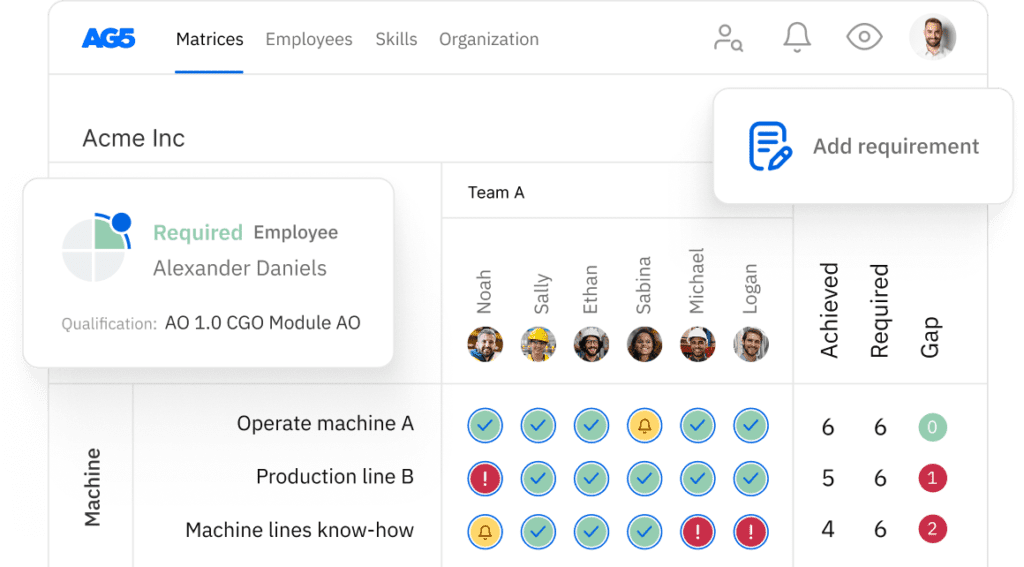What is reskilling: Benefits & how to reskill your workers
In this article, we discuss the imperative of reskilling the workforce, as projected that 50% of employees will require reskilling by 2025. It emphasizes the significance and strategies for effective reskilling initiatives.

What is reskilling?Copied
The required skill sets for employees are changing along with the future of work, especially in industrial environments. As a result, organizations must find ways to reskill their workforce to stay ahead of the curve.
In this article, we’ll take an up-close look at reskilling, including its definition, benefits, importance, and how you can begin to set up reskilling initiatives in your own organization, using AG5’s skills management platform to guide you.
Definition of reskillingCopied
Reskilling refers to employees learning new skills or getting new training so that they can better adapt to changes in the job market due to new technologies or processes (or to prepare for a new role).
For example, as factories further shift toward Industry 4.0, automation, IoT, and smart machinery, a line worker previously tasked with manual assembly might need to learn how to operate and maintain robotic arms or CNC machines.
Going further, in the logistics sector, the growth of e-commerce has driven the adoption of automated sorting systems and autonomous vehicles in warehouses, This means that traditional roles, such as forklift operators, are being replaced by automated systems. Workers therefore may need to be reskilled to work alongside these technologies.
Why reskilling is important in modern timesCopied
According to the World Economic Forum’s Future of Jobs Report, 50% of all employees will need reskilling by 2025 as the adoption of new technologies increases. [1] Let’s take a look at several of these technologies, as well as other areas that make reskilling important in today’s business world.
Automation and AI
With the rise of automation and AI, many traditional jobs are being replaced by machines. Not only will workers need new skills to transition into roles that hinge on working with such technology, they may also need new skill that machines cannot easily replicate, such as those involving higher degrees of critical thinking or creativity. For example, McKinsey estimates that by 2030, up to 375 million workers may need to switch occupations. [2]
Digital transformation
In addition to automation and AI, many industries are making the switch from toward digital platforms. This means that many organizations are and will increasingly rely on employees who are proficient in digital tools and processes. A Salesforce survey found that 86% of workers believe they need more digital skills to keep pace with technological changes in their workplace [3], further highlighting the need for effective reskilling programs.
Skill gaps and continuous improvement
According to [4]PwC’s global CEO survey, 74% of CEOs are concerned about the availability of key skills in their industries, driving the need for continuous learning in employees’ careers. Reskilling is a great way to ensure that employees have the skills their organizations need – proactively filling skills gaps and ensuring that operational delays are as least costly as possible.
Environmental sustainability
There could be as many as 24 million new jobs and roles focused on renewable energy and the environment by 2030, predicts the International Labour Organization. [5] Here, reskilling would be critical, especially for organizations and employees that operate or work in traditional industries like fossil fuels, as it would help them transition into green roles.
Benefits of reskillingCopied
Reskilling initiatives don’t just ensure that your organization can stay competitive and relevant, they also offer various other benefits that can help your organization operate more efficiently and effectively. In this section, we’ll examine the benefits of reskilling.
Boosted productivity
When employees are equipped with skills that align with the latest technologies and processes, they can work more efficiently, take on more responsibilities, and make more meaningful contributions in their roles. In turn, this can result in both and individual and organizational-wide productivity boost.
Fewer skill gaps
Organizations often face skill gaps, especially in areas like digital proficiency, data analytics, or emerging technologies. Reskilling initiatives help close them, allowing organizations to meet new challenges without relying solely on external recruitment.
Increased employee engagement and retention
Employees are more likely to stay with a company that offers reskilling opportunities. A LinkedIn Workplace Learning Report, for example, shows that 94% of employees would stay with a company longer if it invested in their career development. [6]
Cost-effectiveness
Hiring new employees is much more resource-intensive than reskilling existing workers. This is because reskilling uses existing knowledge and experience as a springboard, off of which workers can more quickly learn new skills that are often related to their current roles.
Better adaptability and agility
Organizations with workforces that regularly update and improve their skills are more adaptable to change. They are also quicker to respond to new technologies, industry disruptions, and shifts in market or consumer demand.
How to reskill your workersCopied
Reskilling employees isn’t necessarily a short process, but you can create a plan that helps such initiatives run as smoothly as possible. Here’s a quick step-by-step guide to setting up reskilling initiatives in your organization.
- Identify skill gaps. Conduct a skills gap analysis, which can help you visualize the skills your organization has and needs
- Set clear goals. Define the objectives for your reskilling initiative. These could include identifying roles that need to be filled, the skills employees need to adequately perform them, and how they will contribute to the overall success of your organization
- Create personalized learning paths. Tailor training to the needs of individual employees. Whether these are online courses, workshops, mentorship, or hands-on projects will depend on the employee and role, however they should always take into consideration an individual’s learning style
- Promote cross-training. Encourage employees to learn skills from other teams or roles. This will broaden their skillset, as well as improve collaboration and adaptability across the organization
- Monitor industry trends. Don’t just focus on your own organization. Be sure that you are also staying up to date with new technologies and industry trends that could impact your business, then update your reskilling strategy accordingly
- Use the right technology. Make use of platforms like learning management systems (LMS) or skills management software tools that can automatically help you develop, monitor, and analyze your reskilling programs
- Track progress. Be sure to use the data you collect during the course of any reskilling programs to help you better determine their efficacy and prepare for the future. The right skills management software will have such features built into the platform
Reskill your workforce with AG5Copied
AG5’s skills management software allows you to create efficient reskilling programs that help ensure your organization is as productive as possible. The platform is an excellent, intuitive, and easy method of tracking employee progress and measure the success of your reskilling initiatives.
With AG5 you can:
- Identify skills gaps – showing what employees can currently do and what the organization needs employees to do
- Lay the foundation for targeted training – ensuring that your reskilling initiatives are aligned with your organization’s needs
- Track progress and performance – providing insight into certification statues and overall organizational compliance
- Allocate resources – directing business leaders and managers to the areas that require the most attention and ensuring that training budgets are used optimally
- Plan for succession – identifying critical skills in employees leaving or retiring, thus helping in reskilling, upskilling, or recruitment to fill these positions
Want to see how it works? Schedule your free, live, 15-minute demo today.
Sources Copied
- Change view: Table
-
APA
| # | Source title | Description | Publication | Retrieved | Source URL |
|---|---|---|---|---|---|
| 1 | The Future of Jobs Report | World Economic Forum | October 20, 2020 | October 18, 2024 | https://www.weforum.org/public.. |
| 2 | Retraining and reskilling workers in the age of automation | McKinsey | January 22, 2018 | October 18, 2024 | https://www.mckinsey.com/featu.. |
| 3 | The Future of Digital Skills | Salesforce | January 27, 2022 | October 18, 2024 | https://www.salesforce.com/new.. |
| 4 | Upskilling: Building confidence in an uncertain world | PwC | April 28, 2020 | April 28, 2020 | https://www.pwc.com/gx/en/ceo-.. |
| 5 | 24 million jobs to open up in the green economy | International Labour Organization | May 14, 2018 | October 18, 2024 | https://www.ilo.org/resource/n.. |
| 6 | LinkedIn 2024 Workplace Learning Report | February 22, 2024 | October 18, 2024 | https://learning.linkedin.com/.. |
Author Copied
Revisions Copied
Rewrote existing content, added “Benefits of reskilling” and “How to reskill your workers” section, added additional steps to “Why reskilling is important in modern times”, added sources.
Written by: Gea Vermast

